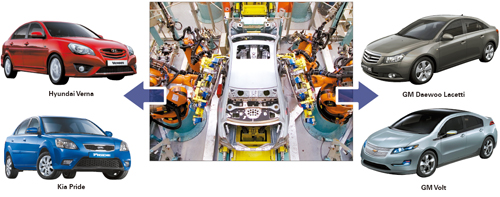New car, same as the old car

Using similar architecture in multiple models cuts costs and speeds up the design process. The two vehicles to the left, from Hyundai-Kia Automotive Group, share a platform, as do the two GM cars to the right. [JoongAng Ilbo]
The platform is a preset package of basic parts including the underbody, engine, transmission, suspension and steering.
For instance, the “all-new” Cadillac SRX, a premium crossover car, was built on the same platform as the Winstorm, from GM’s local unit GM Daewoo. Still, the two look different, which is why the SRX caught the media’s eye when it was introduced in Korea in November despite the Winstorm being sold here since 2006.
The million-selling Avante by Hyundai Motor, the country’s largest carmaker, also shares its platform with the Hyundai i30. The Kia Forte, from Korea’s No. 2 carmaker and a Hyundai affiliate, also uses that platform.
The sport-utility vehicles the Hyundai Tucson and Kia Sportage are also built on the same foundation.
Automakers do this to cut costs. In fact, the Hyundai-Kia Automotive Group plans to have all the cars in its lineups use just six platforms by 2012. Today, over 30 Hyundai and Kia models are made based on about 18 different platforms, down from 29 models and 22 platforms in 2002, though those are only estimates since the company has not revealed precise figures.
“Platform integration is a strategy taken by global carmakers,” said an official at Hyundai-Kia. “Producing cars from the same platform can reduce cost. As technologies advance, carmakers will be able to produce very different cars from the same platforms.”
Hyundai’s local rivals are following suit. Ssangyong Motor is basing its eight models on two platforms, with the Rexton, Kyron, Actyon and Actyon Sports in one group and the Rodius, Chairman H, Chairman W and limousines in the other.
“The C200, Ssangyong’s new car to be released beginning in June, will be made on a third platform,” an official at the company said.
Renault Samsung, the local unit of the French carmaker, produces cars based on platforms co-developed by Renault and Nissan. Its flagship SM5 shares a platform with Renault’s Laguna, the SM3 with the Renault Megane and the QM5 with the Nissan Rogue.
Back at GM Daewoo, the Lacetti Premiere’s architecture is shared with the upcoming Volt and the Orlando.
Globally, Volkswagen Group, the biggest European automotive group, is among the most advanced in platform sharing. Since the 1990s, the group has reduced its 16 platforms to just four.
Since being taken over by Renault in 1999, Nissan has also tried to standardize its designs. Once it sold the same number of models as Toyota despite having sales less than half the Japanese behemoth’s, but today it’s simplified, epitomized by the FM platform. This structure places the engine at the front for well-balanced weight distribution, and it is now at the core of many new Nissan cars.
Some luxury brands use the platform concept. The Lamborghini Gallardo and Audi R8 share the same aluminum chassis, semi-automatic transmission and V10 5.2-liter engine. Engineers for the Porsche Cayenne and Volkswagen Touareg used platform integration and the cars feature the same underbody and air suspension.
By Moon Gwang-lip, Park Yeong-wung [joe@joongang.co.kr]










with the Korea JoongAng Daily
To write comments, please log in to one of the accounts.
Standards Board Policy (0/250자)